#Story structure
Text
Hello I’m here to talk about an opinion that isn’t so much unpopular because people don’t like it, but because it is splitting hairs and basically an argument based in semantics that sane people reasonably do not waste their time caring about it.
I am neither sane nor reasonable and therefore think about this a lot, and get ready to pull out a soapbox and type the Text Wall of China any time I hear people offhandedly contradict this opinion, and so I have come here today to die on this molehill, and write the over-long post of my dreams, because fuck it, it’s my blog.
Drumroll please:
Sauron is not The Lord of the Rings
The Lord of the Rings is the main antagonist though, so furthermore,
Sauron is not the main antagonist of The Lord of the Rings
I internally go insane every time someone says “Sauron, the eponymous Lord of the Rings” or “The antagonist never actually appears in Lord of the Rings” or uses Lord of the Rings as an penultimate example of having a flat ‘evil for evil’s sake’ villain. This is mostly in YouTube videos so I’m not calling out anyone here.
So who is the Lord of the Rings? Where do I get this shit? Why should anyone care?
I will tell you in far too much detail under this cut, because I told you I was gonna be extra about it and this is already long enough to inflict on my followers without their consent.
First and foremost, Frodo is not the Lord of the Rings either. Let’s get that out of the way. Gandalf explicitly tells us that in Many Meetings (the first chapter in Rivendell in Fellowship), when Pippin greets a newly awakened Frodo with quintessential Fool of a Took™️ swagger.
‘Hurray!’ cried Pippin, springing up. ‘Here is our noble cousin! Make way for Frodo, Lord of the Ring!’
‘Hush!’ Said Gandalf from the shadows at the back of the porch. ‘Evil things do not come into this valley; but all the same we should not name them. The Lord of the Ring is not Frodo, but the master of the Dark Tower of Mordor, whose power is again stretching out over the world! We are sitting in a fortress. Outside it is getting dark.’
So that’s my theory busted right off the bat! Gandalf straight up tells us the Lord of the Ring is Sauron (‘the master of the Dark Tower of Mordor’ which is Sauron).
But I already told you, this is a hair-splitting semantics-based theory! He said Sauron was the Lord of the Ring. Not the Lord of the RingS. Yes, this whole theory revolves around a single letter difference between the title of the series and Gandalf’s statement, WHAT OF IT?
But in all seriousness. Tolkien was a linguist. There was no way this choice was not deliberate, not on something so important to the narrative. And there is a very important difference between what he is referring to when he uses ‘The Ring” singular, and “The Rings” plural. The Ring that Frodo carried to Mordor has it’s singular nature highly emphasized by the language that surrounds it. THE definite article Ring, the ONE Ring. Just the One. Singular Singular Singular.
The Rings (plural) refers to the rings of power which Celebrimbor wrought, with Sauron’s help, but Sauron is objectively not the Lord of those rings. Not the three Elven ones at least, which he never touched and only suspects the location of. Without his One Ring he has no power over the Three, and a big problem with him regaining his Ring is that he would gain power over those rings, the ringbearers, and the safe realms that had been wrought with them, basically crippling those with the power to resist him.
Him NOT having the Ring, and therefore NOT having lordship over all the rings, is a pretty major plot point. Like, it’s not a reach to say Sauron not having the Ring is what drives the entire story. And he is NOT the Lord of the Rings without it.
And he never gains it, so is the whole series named after Sauron’s aspirations, that the main characters are trying to prevent? I mean, from an angle yes. But also no.
Because while Pippin and Gandalf’s exchange is the closest we come in the text to seeing the title, let me show you the only place within the covers that “The Lord of the Rings” is presented, at least in my beat up third hand 70’s edition. It may not be formatted like this in other editions, but I still think it says something about how we are supposed to read the title:

[Image ID: Masking tape can clearly be seen holding together my poor abused copy of Fellowship, open to the title page. THE LORD OF THE RINGS is written across the top of the page in all caps, directly below it is the Ring Poem, as if The Lord of the Rings is a the title not only of the series but of the poem. /.End ID]
The One Ring is the Lord of the Rings, not Sauron, who is the Lord of the Ring.
“What?” Say imaginary naysayers in my head, “How can a Ring be a Lord? And why does this matter, if Sauron is the Lord of the Ring, doesn’t that make him the Lord of the Rings by proxy? Why are you wasting your and my time making an argument about this?”
I’m glad you asked imaginary naysayer, let me speak to your first point. How can a ring be a Lord? Well, like any good first time speechwriter, I’ve turned to Miriam Webster, and asked it to define a word we already know, in this case ‘lord.’

[Image ID: Screenshot of the Miriam Webster definition of ‘lord.’ The ones that are relevant are 1: One having power and authority over others. 1a: A ruler by hereditary right or preeminence to whom service and obedience are due. And 1f: One that has achieved mastery or that exercises leadership or great power in some area /.End ID]
In the poem, it is the Ring that is spoken of as ruling, not Sauron. Sauron is actually listed in the same position as all the others who receive rings, “The Dark Lord on his Dark Throne” occupying the same place in the sentence structure as the “the Elven-kings under the sky” and “the Dwarf-lords in their halls of stone” and “Mortal Men doomed to die.” It is the One Ring, not Sauron, who rules them all, fulfilling our first definition “A ruler by hereditary right or preeminence.” In this case it would be by right of preeminence, or superiority. The One Ring outclasses the other rings and thus dominates them, binding them to obedience and service. Gandalf calls it “the Master-Ring” when it is first revealed for what it is in Bag-End with the words appearing from the flame.
The Ring has it’s own will too. It’s repeatedly stated to be in control of Gollum when Gandalf is first telling us about it. I’m literally so spoiled for quotes about this that I was paralyzed with indecisiveness over what to use but let’s keep it simple with this one. It’s from Gandalf explaining why Gollum didn’t have the Ring allowing Bilbo to come upon it in the chapter “Shadows of the Past” from Fellowship:
‘It was not Gollum, Frodo, but the Ring itself that decided things. The Ring left him.’
So if Sauron is the Lord of the Ring, and the Ring is the Lord of the Rings, isn’t he Lord of the Rings by proxy? Yes, when he has the Ring. But also being the ruler of a lord doesn’t make the title of that lord your title, if that makes sense. People don’t call Aragorn the Prince of Ithilien, that’s Faramir’s title, Aragorn is King of the Reunited Kingdoms, he rules Ithilien, sure, but by proxy. Ithilien reports to Faramir who reports to Aragorn (I should be calling him Elessar since I’m talking about him as king, but whatever). If Aragorn lost the ability to contact Faramir or Ithilian, he would still theoretically be king there but he would have no practical control, just like Sauron with the Rings of Power.
Why does this matter? It mostly doesn’t. It does not change anything practically in the story at all.
But it matters to me, because it might help change perspective on the antagonist of LotR. It’s the Ring. Sauron is a force in the world, one the Ring is closely allied with, and from whom many of the obstacles come, but the entity that our protagonist is really fighting on every page is the Ring.
If Gandalf were the main character, or Aragorn, or almost anyone else on Middle Earth, Sauron would be the Primary Antagonist. But they are not. Frodo is the Primary Protagonist, and his struggle is NOT against Sauron, it is against the Ring.
If destroying the Ring had not destroyed Sauron, would Frodo have kept fighting in this war? NO! He had his task, and once it was done he was done, even if the world ended afterwards. Everything is driven by the Ring. The threat to the Shire comes from the presence of the Ring, so Frodo takes the Ring to Rivendell. The danger of the Ring is not neutralized by it being brought to Rivendell, so he continues his journey to destroy it once and for all. He doesn’t fight Sauron, he fights the Ring. He fights with himself to keep going in spite of the despair it levels on him, the poisonous words it whispers in his ear, the physical toll it takes on his body. He fights Boromir and Sam (not to the extent he does in the movie, but still a bit) and Gollum over the Ring. He negotiates with Faramir over the Ring.
And the Ring is SUCH a more interesting and nuanced villain to struggle with than Sauron. Sauron is representative of a force in the world. He controls events but never appears, because he acts as the source of all evil, it’s representation on earth (at least now Melkor is in the Void), but it is far more interesting to watch the effect he has on others than deal directly with a character that is so obviously in the wrong in every way. Making Sauron a physical character in LotR is like making the Devil a present character in basically any piece of media that deals with evil.
Evil at its purest isn’t that interesting, because it contains no conflict. Leaving Sauron as an offscreen player leaves us to see characters that are not pure evil struggle with that conflict.
The fascinating thing about the Ring is that it has no power outside of what you give it. But given enough time even the best people, like Frodo, will end up losing themselves to it, as it whispers in your ear with your own voice.
I want to go ballistic when people point to LotR and say it has a one dimensional villain. EVERYONE’S OWN VIOLENCE, DESPAIR AND THIRST FOR POWER IS THE VILLAIN OF LORD OF THE RINGS! Brought to the fore by a small unassuming golden trinket which just happens to also be the titular Lord of the Rings.
Honestly “The Ring is the Villain of LotR change my mind” should be its own big long post with lots of quotes and shit, the fact that the Ring is The Lord of the Rings just being a small point in it.
But unless you are a specific type of interested in story structure and stuff none of this is at all meaningful and it really, really doesn’t matter, so I’m gonna go.
Thanks for coming with me on this dumb journey.
#tolkien#jirt#lotr#lord of the rings#the one ring#Sauron#jrr tolkien#Frodo#story structure#long post… even for me!#hot take#Gandalf#look#I’m sorry ok#this is so inconsequential and I say this as someone who likes meta
8K notes
·
View notes
Text
Indigenous Storytelling
A lot of the stuff I've posted so far is pretty white western-centric views of telling stories. The whole article is very informative! An excerpt:
"Many of the main characters in Plains Indian mythology never end. Not only are they immortal and indestructible—where they may be killed in one story and are right back at it in another—they also age with the listener. Coyote stories for children have childlike morals; for teens Coyote is a much rougher character; and, for elders only, grandpa Coyote is smart, and his stories are deep and filled with complicated plots and plans."
#american indian#indigenous#native american#stories#myths#storytelling#story structure#story#writing#on writing#rightwriter#writing advice#nanowrimo 2023#preptober#nanowrimo#writer#writing tips
543 notes
·
View notes
Text
Let’s Talk About the Ferris Wheel
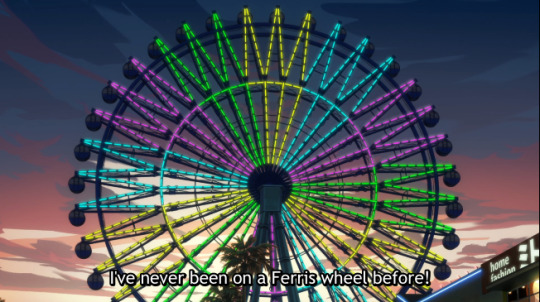
This scene in the Ferris Wheel is incredibly intimate. We have Kazuki and Rei actually communicating with each other and discussing seriously about the current situation they are in. But, before that, let’s take a moment to talk about this sequence of events with Rei and Miri.
Miri asks Rei:

“Are Ferris wheels scary?” And Rei tells her no, that they aren’t.
Once they’re on the Ferris wheel, Rei asks Miri:

“It’s not scary?” And Miri replies that it’s not.
This is interesting dialogue, because for Kazuki and Rei, this Ferris wheel ride probably is quite scary, right. An adult fear: losing a child they’ve come to care for and have become attached to.
But, the narrative is telling us that: The Ferris wheel is NOT scary.
Hopefully, this means that we don’t have to be scared about the future plotlines, maybe shocked and surprised, but not scared.
Of course, we can also look at the projection of the Ferris wheel and the conversations and dialogue as being related to the plot structure of the series so far, and the mindset of the characters at those junctures.
Right, before they got on this ride of caring for Miri, the thought was rather scary, because they were both out of their depths. Then, we get a shot of the carriage they are in, and it rising up the Ferris wheel:
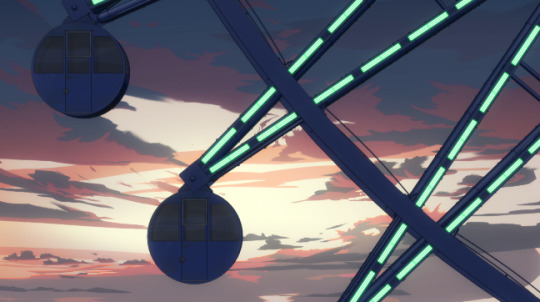
It’s after this that we have Miri responding to Rei that it isn’t scary. This is around the time the two decided to be her papas and started getting comfortable within their roles as being Miri’s papas. Around Episodes 3 - 6. Seeing them become more and more like a family with each passing episode was beautiful (still is).

As they’re getting closer to the very top of the Ferris Wheel, Kazuki brings up the cat. A difficult conversation, one that deals with attachment. In Episodes 7 - 8, that’s when we really see Kazuki and Rei’s decision to devote themselves to Miri and their family come into full force.

Their attachment with Miri really kicks in around Episodes 7 - 9, this is when they start thinking about placing Miri first, like Kazuki mentions here:
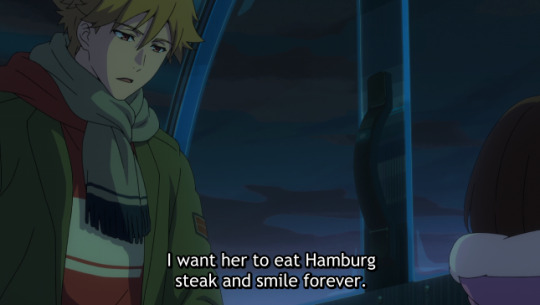
He talks about wanting her to eat Hamburg steak and smile forever. He’s placing her happiness first. That’s an extremely parental view. Kazuki is expressing the practical side of parenthood, while Rei’s expression here, the sound of upset he makes:
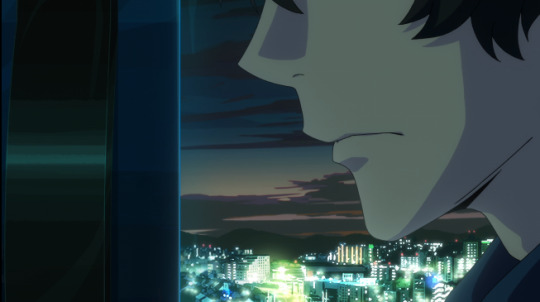
Highlights the emotional and painful side of making such a decision. Rei’s never felt emotional attachment like this before, never had to lose it either. Kazuki has, though it was unintentional and not the same as this situation.
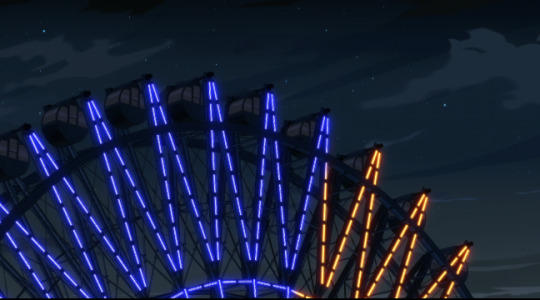
The Ferris wheel is now shown to be at the top. The climax, episodes 9 and 10. Episode 9 was the climax of them becoming a family unit - Kazuki and Rei had worked through their individual demons and both picked returning home to their family. And in Episode 9, we see Miri acknowledging Kazuki and Rei as her family. That was the climax to the “family” side of the series.
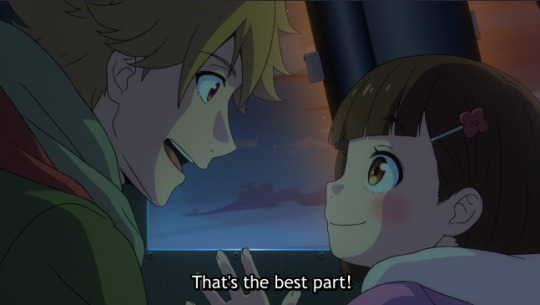
Kazuki tells Miri, when they reach the “tippity-top” that: “That’s the best part!” And, it was! Episode 9 was so, so heartwarming.
But, this week’s episode, Episode 10, is in the falling action. The part where shit gets tough again. Just like it got tough for Kazuki and Rei in the rising action of Episodes 7 & 8, it’ll get tough for them again in Episodes 10 & 11, possibly 12, too. The difference being that this time they are facing it together, instead of separately.

Kazuki acknowledges that he’s gotten more than he thought he ever would thanks to Miri:
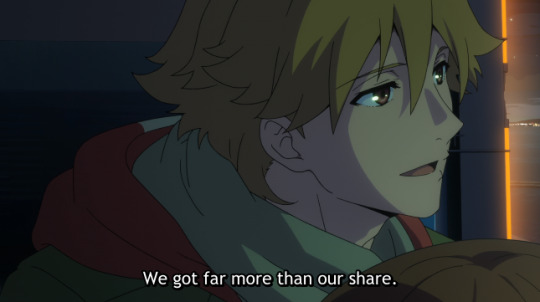
And Rei’s grown a lot emotionally because of Miri, experienced things he never thought he would. He’s become a much more functioning person since she’s come into his life:

For them, this seems and feels like the end of the ride. But, it’s not. The Ferris wheel is still in the falling action stage:
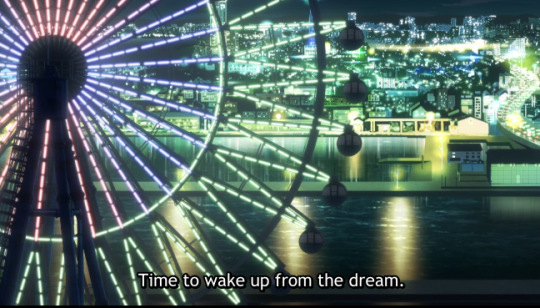
They haven’t gotten off the ride yet. And we don’t see them get off the ride (we just see them after it’s done). Kazuki says, “Time to wake up from the dream,” as they are going down. But waking up from a dream is different from a dream ending.
In the previous acts of the series, Kazuki and Rei were aware of the dangers their job and situation with Miri could place Miri in, but they weren’t facing the realities of their situation either.
Now the story is in the falling action, the characters are facing some harsh realities:
About their job.

About society.
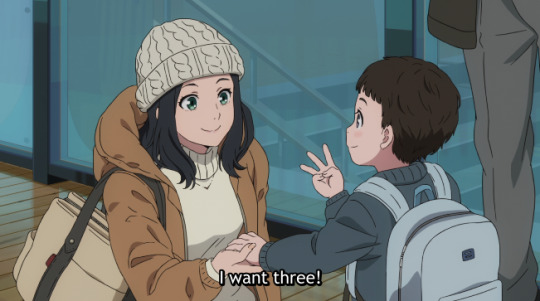
About Miri’s birth mother.

Buddy Daddies is a series that wants to explore the themes of “a bloodless family” and “two people of the same sex raising a child,” and they are doing it in modern day Japan. Not in a fantasy world, not through metaphors, and with a foundation based in some level of reality.
This series is exploring tough themes that aren’t always easily accepted or easy to navigate in real life. These ideas can be challenging, and right now, our main characters are experiencing that.
Pushback.
Kyutaro with his hard truths about the messiness of Miri’s parental situation, of them killing her birth father, and the fact that these issues are going to eventually catch up to them.
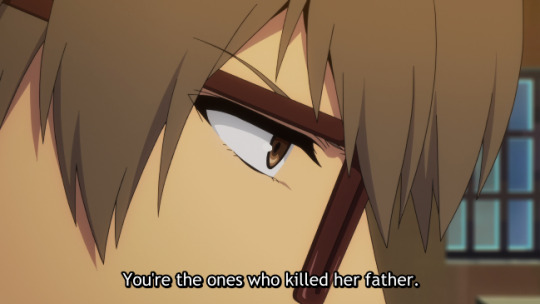
Misaki reiterating that danger, and having the lawful advantage of being Miri’s blood, while Kazuki really takes in the reality that society, especially Japanese society, still centers motherhood when it comes to childcare.
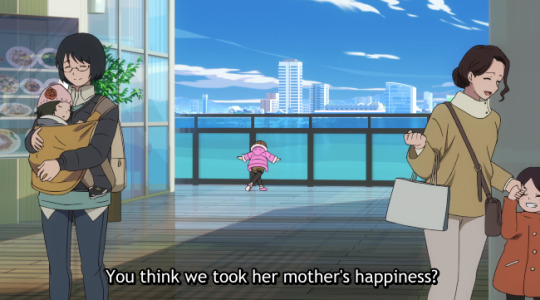
But, like I stated, this is still just the falling action. It’s not the conclusion. There are three more episodes left.

There is still time for them and things to change. But, like Kyutaro stated back in Episode 5, it still remains to be seen if these changes that will come will be for the better or worst.
#Buddy Daddies#BD#Kazuki Kurusu#Rei Suwa#Miri Unasaka#Kyutaro Kugi#Misaki Unasaka#BD spoilers#Buddy Daddies spoilers#long post#image heavy post#meta post#analysis#story structure
1K notes
·
View notes
Text
So one thing I’m noticing rewatching OFMD s2 is that the more episodes in a row I watch, the less the pacing problems of any one individual episode bother me—particularly in episodes 6-8 where I think they were struggling the most to hit all the beats they wanted to. This makes me think about alternate release schedules and how our perception of the episodes might have changed based on how they were grouped together. Some possibilities to imagine:
1-2 / 3-4 / 5-6 / 7-8
Pros: two a week. Nice and even. We would’ve been losing our damn minds at that episode 2 cliffhanger the first week of the season.
Cons: Mermaid Stede impact somewhat lessened; 1-3 really do make a nice package. First kiss of the season + first fuck in the same week would’ve been a LOT.
1-3 / 4-5 / 6-8
Pros: I know they wanted to spread it out over 4 weeks but this actually makes the most sense structurally. Separates 5 and 6.
Cons: Imagine if we’d been processing 6, 7 and 8 all at once.
1-3 / 4-6 / 7-8
Pros: this would also make sense from a structural standpoint. Probably the most tonally coherent option.
Cons: 5 and 6 are together again.
1-3 / 4-5 / 6 / 7-8
This would have been unhinged but brilliant. We all would have guessed what made 6 a Very Special Episode worthy of its own solo release week and we would have been so happy to be right.
264 notes
·
View notes
Text
Young Royals and the three act structure, Part one
Seems like there was some potential interest in a full three-act story structure analysis, so I’m taking this opportunity to indulge myself by going full nerd. I’m going to attempt to make the argument that limiting the show to three seasons is actually perfect for Young Royals, by highlighting the pattern the story follows.
A few things to keep in mind before we start.
This analysis is not about the characters deep inner emotional lives. We are not here to pass judgment on their actions. We are simply identifying the beats of the story in a neutral and objective manner, for the purpose of analysing the structure of the story.
As you will notice, the points I have identified are all from Wilhelm’s perspective. That’s because he’s the point-of-view character, the main conflict is shaped by him and his emotional state. He’s the protagonist. Each subplot however, will follow the same pattern and has its own purpose, but I’ll get more into that another time.
I’ll be referring a fair bit to Lindsey Ellis’s video essay on the subject, because I like how she describes the structure pattern in sequences. So I’m gonna borrow some of her language. Also, note that the examples she uses to describe the tree-act structure are all feature films. Since Young Royals is a series, it’s gonna divert slightly from her description. But that’s what is so great about this structure, it’s flexible. It’s not meant to be set rules, but rather guidelines to help keep your story relevant and engaging all the way through. If you find this stuff interesting, I’d highly recommend watching her videos!
The three act structure is absolutely not the only way to tell a story. There’s many different formats that works just as well! It’s really about finding what structure works best to tell your story. The three acts however is the most common format you’ll find in more commercially viable works, such as Disney films for example.
And finally, I’m not a writer, but an animator, and I have studied film theory/structure. I’ll do my best to motivate the plot points I’ve identified, but if you’re a proper story expert and disagree with me, I’m happy to discuss!
Okay, let’s get to it.
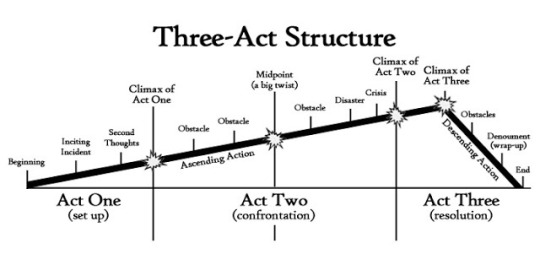
A three-act structure is constructed of just that, three acts, and roughly looks like this. Essentially, a beginning, a middle, and an end. Or the set up, the confrontation, and the resolution. These acts may vary in length, act two usually being the longest and act three usually being the shortest. But what truly defines them is the tension of each act, meaning what drives the conflict forward at that point. A story will have a main conflict yes, but that conflict will take on many forms depending on where we are in the story. Lindsey Ellis describes each act as consisting of multiple sequences, and defines each sequence by its individual tension as well. Though all points of tension should always stay related to the main conflict! So the main points we’re looking to identify in the story are the main act tensions and the main sequence tensions.
Let’s go through season one of Young Royals and talk about each story beat.
Act 1
Act tension - Wille has to attend Hillerska.
Sequence 1
We start with the Set up/Hook. The purpose here is to establish the world and the protagonist along with their internal conflict, such as their flaws and/or desire that makes them feel incomplete - The way Wilhelm’s character is introduced informs us that he is royal, but struggling with his role, because royals have set rules to follow.
“Why can’t I decide how the hell I want to live? I want to live a normal life!”
The thing that sets the story in motion is the point of attack. Something happens that is outside of the protagonist's control/knowledge - That would be the royal court deciding to send Wille to Hillerska without his permission. This gives the protagonist something to react to.
Sequence tension is established - Wille does not want to go to Hillerska. The rest of episode one reinforces Wille’s discomfort at the school.
Next, we get to the inciting incident. An event that disrupts the status quo, and our protagonist has to get involved - The initiation party, particularly when Wille and Simon almost kiss at the end. This leads him to acknowledge his attraction toward Simon and become more proactive in his pursuit of the boy.
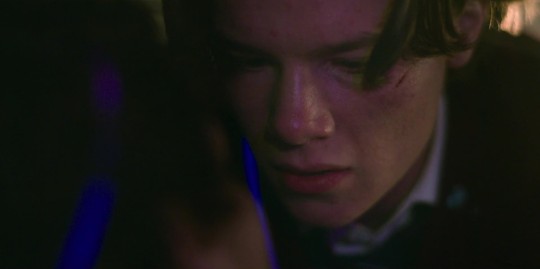
The sequence tension is resolved. Notice how in episode two, Hillerska is no longer the main focus for Wille, but Simon is. The seeds for what will become the central conflict have now been planted. The conflict is usually driven by character motivation. This is where we can consider the protagonist's Want vs Need. The want drives the main tension - Wille wants to be with Simon. But we’ll find want he needs later on in the story.
Sequence 2
The purpose here is to build up the creation of the main tension of the story. The main antagonist can also be established here - August keeps getting on Wille’s nerves. Especially when he’s trying to hang out with Simon.
That’s our sequence tension - Wille is working to befriend Simon, but August keeps getting in the way.
The end of the sequence sees the first major plot point, the Lock-in. Where our protagonist makes a decision that changes everything. Usually, something they can’t come back from - In Young Royals that would be the first kiss. Wille and Simon’s relationship has fundamentally changed. The main tension is now established.

Act 2
Act tension - Can Wille be with Simon, despite him being a prince?
Sequence 3
At the start of this sequence, the protagonist has most likely achieved some kind of milestone or learned something - He’s definitely like that.
To keep the story interesting, writers will add so-called pinch points in between the bigger plot points. These usually act as reminders of the antagonist or the pressure our protagonist may feel - Wille feels he needs to break it off with Simon because a prince is not supposed to be gay. As we established in the set up, royals have rules.
Sequence tension - Can Wille deny his feelings for Simon? Queer pining ensues.
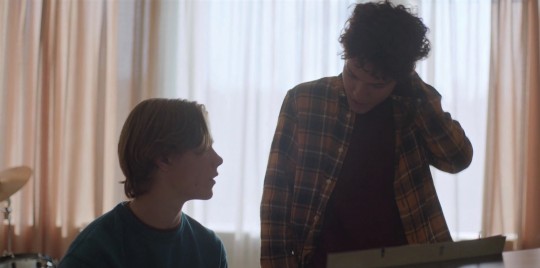
Sequence 4
The purpose of this sequence is to build up towards the midpoint. We see the protagonist making attempts to achieve their goal - The want never changed, Wille still wants to be with Simon, despite the pressure. Wille invites him to spend the weekend with him.
Sequence tension - Wille is trying to prioritise his new relationship with Simon, but August is still being annoying.
Then the midpoint hits. A major disruption, either from a character action or a force of nature. Can be positive or negative, just something that changes the aim of the quest without resolving the main tension - This time it’s literally halfway through the season. End of episode three, Erik dies and Wille becomes the crown prince. Everything has changed.
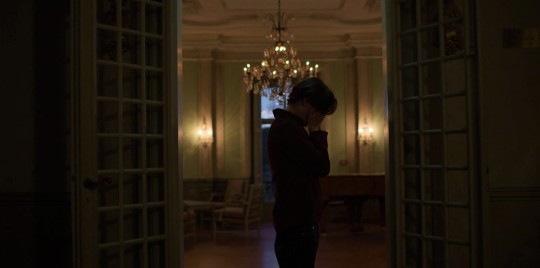
Sequence 5
Everybody has to adjust to the new world order after the midpoint disruption. We’ve reached another pinch point - Again we are reminded that royals have rules, and Wille makes another attempt to follow those rules. By embracing his new role, he breaks up with Simon once again, then sort of pursues Felice and joins the society.
Sequence tension - Wille adjusting to his new title while mourning his brother.
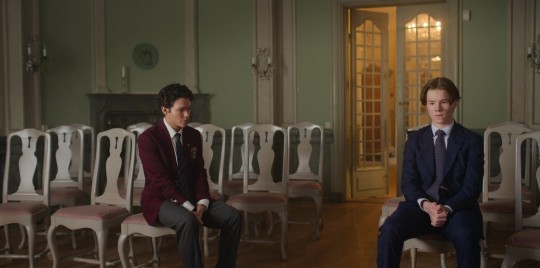
It’s common for subplots to advance around this time - Like Simon giving August the drugs to sell.
Sequence 6
Another plot point, where our protagonist may stop and reflect. Maybe have a heart-to-heart with another character, and perhaps make a decision - This is where we see the football field scene and the end of episode four. Wille reaches out to Simon for help, reconnecting with him. This leads them to pursue a relationship once again. They are put in a false sense of security. They are finally together, thinking all is good. BUT, we in the audience know that August has the video of them and the writers keep reminding us of him and the threat he poses. Even if Wille and Simon don't know it yet.
Sequence tension - Can this happiness last?
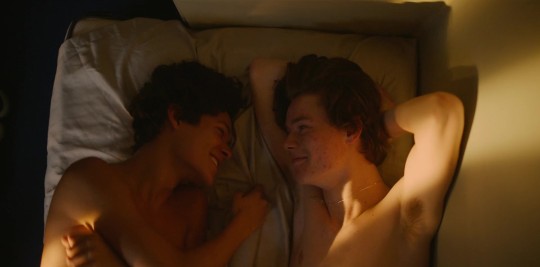
Sequence 7
(Here’s where the story leaves the classic structure for a bit, and adds an extra sequence for some more drama, as filler. In theory, they could have skipped this sequence and gone straight to the video being released. This part is mainly here to give motivation for August’s character, making his actions clearer)
So we are essentially given another pinch point, a reminder of antagonist or pressure - August tries to break them apart by telling Wille about the drugs, which leads to the music room fight.
Sequence tension - August is becoming more hostile.
Wille saving Simon from being framed for the drugs is more related to August’s money subplot. And the Lucia hug scene is mainly there for character building purposes. I’ll talk more about that stuff in part two.
The plot has advanced to the culmination of the main tension. The crisis that serves as build-up to act three - August releases the video. At the end of act two, the protagonist faces their biggest challenge yet. They’ve hit their lowest point - The aftermath of the video's release and Wille is totally lost.
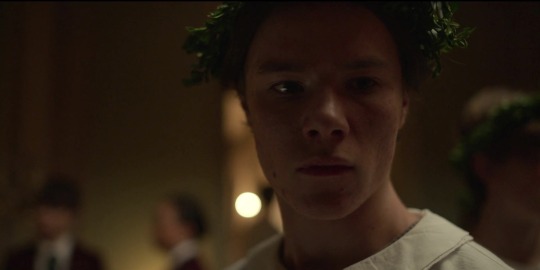
Act 3
Act tension - Can they save their relationship after the video?
Sequence 8
Begins with the protagonist making a big decision that creates the new act tension. The tension in act three will be different, but still related to the main conflict - Wille and Simon talk in the locker room, where Wille says he won’t do the statement.
Sequence tension - Can Wille avoid making the statement?
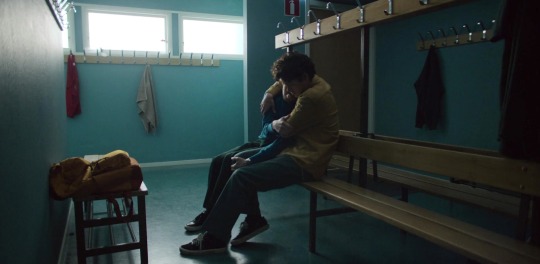
We’ve reached our last major plot point, located at the end of the sequence. Sometimes known as the twist in the third act - And what a twist, Wille does the statement anyway. This narrows down the tension further, to focus on a more character-driven intimate place for the next sequence.
Sequence 9
Sequence tension - Can they be together despite the statement?
Climax, the last big fight - Simon tells Wille off for being selfish and breaks up. Wille also finds out that both August and his mother betrayed him. The protagonist’s need has emerged from this journey and is now clear to us - Wille needs to decide who he wants to be. The want and the need should be different from each other, but still connected. Wille wants Simon, but in order for that to happen, Wille needs to break out of this cycle of self-preservation and stand up for himself against the royal court.
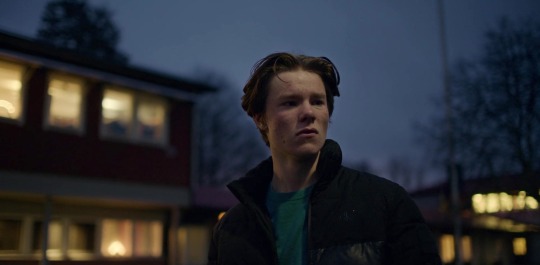
The climax will most likely lead to some kind of character growth - Wille is now pissed because he’s lost everything and realizes how corrupt the royal court is. As Lisa so beautifully put it, “A flame is ignited in him”. Hugging Simon in public is a display of his character growth.
And finally, Resolution. The point where the story is usually wrapped up neatly, but if left ignored, you get a cliffhanger - Which is exactly what happens in this season. Nothing is properly resolved at this point. Resulting in an open ending/cliffhanger.
Oof, that was a lot. How are we all doing? So these are the main beats of the plot. Makes sense? Let me know if you need any further clarification 😅 I was gonna get into how the rest of the show fits this format as well, but that’ll have to be in a separate post. Here’s part two!
#young royals#prince wilhelm#young royals analysis#young royals season 1#film theory#story structure#story analysis#young royals and the three act structure#wilmon#simon eriksson#august horn#my meta#my analysis
239 notes
·
View notes
Text
The 5-Act Story Structure
The 5-Act Story Structure, often associated with classical drama and Shakespearean plays, offers a more nuanced approach to storytelling than the 3-Act structure. It is designed to provide a deeper exploration of themes, characters, and conflicts. This structure is divided into five parts: Introduction, Rising Action, Climax, Falling Action, and Denouement.
Act 1: Introduction sets up the story by introducing characters, settings, and the initial situation or conflict.
Act 2: Rising Action builds upon the foundation laid in the first act, developing the story's main conflict and complicating the characters' lives.
Act 3: Climax is the turning point of the story, where tensions reach their peak, and the main conflict is confronted head-on.
Act 4: Falling Action deals with the aftermath of the climax, leading towards a resolution but still containing elements of conflict and tension.
Act 5: Denouement resolves the remaining conflicts, wraps up loose ends, and concludes the story, often leaving the audience with something to ponder.
The 5-Act Structure is particularly suited for stories that require intricate plotting, detailed character arcs, and a gradual buildup to a climactic confrontation. It allows for a more layered exploration of themes and a complex interweaving of subplots, making it ideal for epic narratives, complex dramas, and stories with a wide scope of characters and settings.
Compared to the 3-Act and 7-Act structures, the 5-Act structure offers a balance between complexity and manageability. It’s best used when the story demands depth and complexity but still needs to maintain a coherent and focused narrative arc. It is perfect for stories where the journey, including its ups and downs, is as important as the destination.
Happy Writing!
See Slaying Fiction for more fun posts!
#writing#novel writing#tumblr writers#writer#fiction#creative writing#writeblr#writing community#writing tips#writing advice#5-act#story structure#story writing#slaying fiction
59 notes
·
View notes
Text
One more time
A Positive Change Arc -- often called a Hero's Journey -- is one possible shape a story can take. It is not the only or the best character arc, it's just one option. In a Positive Change Arc, the protagonist begins the story believing the Thematic Lie, and must learn and embrace the Thematic Truth over the course of their journey.
TGCF and MDZS are not Positive-Change Arcs. They are Flat Arcs.
(I have not read SVSSS)
A Flat-Arc is a story where the protagonist begins already knowing the Thematic Truth, while the world around them believes the lie. In a Flat Arc, the protagonist will have their knowledge of the Truth challenged and tested, they will be tempted by the Lie, and they will ultimately use their conviction to inspire the world around them to also embrace the Truth.
Flat Arc characters do not need to learn the Thematic Truth. They already know it. They may be seduced by the lie, they may falter, but they will always rally back to the Truth in the end.
(If they ARE successfully converted to the lie, then that isn't a Flat Arc anymore, it's a Corruption Arc, and it's usually a tragedy.)
"But Xie Lian and Wei Wuxian learned--" Nothing they learned impacted the Thematic Truth. Did they learn things? Yes! That's how Being A Person works. Both of them DID change and grow as people from the start of the series to the end. But neither of them learned anything that impacted the Thematic Truth. Because they already knew it.
Xie Lian was already kind, he already wanted to help people, he already believed that common people should be protected and uplifted. His suffering at the hands of BWX did not teach him any deep or important lessons. He already knew the Truth. BWX tried to tempt him to embrace the lie -- that people are undeserving, that you should never do anything for anyone who won't grovel with gratitude, that caring for other people is a waste -- and failed, because Xie Lian knew the truth and even when he was at his lowest he was searching for confirmation that he was right. Xie Lian only needed one single act of kindness to reassure himself that he was right and BWX was wrong. He did not learn anything new, he reaffirmed what he already knew and understood.
Wei Wuxian is good, and righteous, and morally upright. He is a character who does the right thing regardless of the consequences he might face. The sects collectively wanted to destroy him because he refused to bow to them, not because he ever at any point actually did anything wrong. Even the vengefulness he showed while actively at war is narratively justified, and it's key that the sects did not care about the desecration of bodies while it served them. He did not learn any valuable or important lessons when the Sects raided the Burial Mounds. The fact that Lan Sizhui exists at all is proof for us as the audience that everything Wei Wuxian did was worth it. All of it mattered, and all of it was the right choice, because a-Yuan is alive. He doesn't come back to life having learned anything new, he already understood the Truth.
Obviously neither of them are Omnipotent. They learn that there's dudes in love with them, they solve the mysteries of their respective true Big Bads, they uncover some other stuff. But the Thematic Truth, the core theme of the story, is not a lesson either of them needs to learn. It is a lesson they teach others by refusing to bend to the Lie the rest of the world believes.
#MXTX#MDZS#TGCF#Heaven Official's Blessing#Grandmaster Of Demonic Cultivation#Xie Lian#Wei Wuxian#story structure#character arc#please I am begging you. Please.#I know school failed you but please#if you are going to try and get into meta#do some research into story theory#do independent studying into how story craft works#I know school probably taught you that the Hero's Journey#is the best or only story structure#but it is not. It isn't even the most common.#school probably also failed to teach you how Themes works#but you really do need to understand them if youre going to try and write deep meta#you cannot dissect a story if you don't understand the pieces it's made of
69 notes
·
View notes
Text
I think that Frodo Baggins and Tiffany Aching are... hmmm. Well, I can't say foils, they aren't in the same story, but maybe reflections of each other. When told about the kinds of problems posed by Jenny Greenteeth, Tiffany says, "What can I do?" When Frodo understands about the need to destroy the ring, without know what that will entail, he says, "I will go, although I do not know the way."
They both do this very interesting thing where they Choose. There isn't really a call to adventure, there's a task that needs doing and they look at it and say okay, here I go. And in doing so, they start to save their respective worlds, intentionally and on purpose. I love it.
#middle earth and the disc have parallel ideas about heroism#tiffany aching#frodo baggins#story structure#middle earth#discworld
117 notes
·
View notes
Text
Momiji, Kyo, and what it means to protect the ones we love (part 5 of 5)
From the beach arc onward, we see Kyo intentionally spending more time with Tohru. He asks her to hang out in Kyoto, he eventually agrees to be in the play, they spend the New Year together, and he does little nice things for her when he can, like washing her scarf, or giving her the paper flower when he sees how upset she is.
This isn't wildly different from S1 Kyo, of course. He's done little nice things for her right from the beginning, like going to pick her up from work in E2. But he's more intentional with it now, and he's aware of his feelings for Tohru and desire to spend time with her. He may still feel unworthy of her, but he finally accepts that his presence makes her happy, so he's willing to quash his self-hatred enough to spend time with her, for her sake.



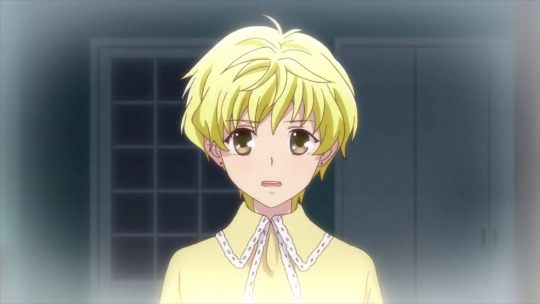

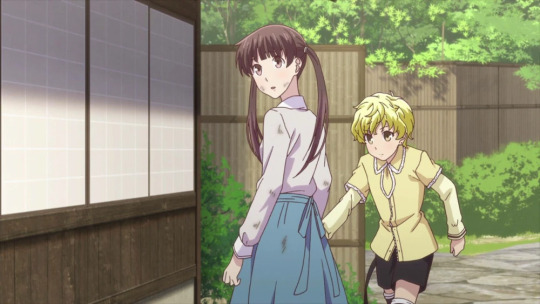
And we see Momiji work at protecting Tohru, most notably in Ask Him For Me, when he tries to accompany her on her mission to find Kureno, and when she insists on going alone, he draws her a map, tells her to stick to the bushes and give his name if she's caught, and tails her to make sure she doesn't get into trouble as she searches for Kureno. (Just look how worried he is! And look at him getting Tohru out of there!) He sees that Tohru feels very strongly about being involved, so he does absolutely everything he can to make sure she can do so as safely as possible. We even see his memory of the night Akito scratched Tohru's cheek, just to make his worries crystal clear.
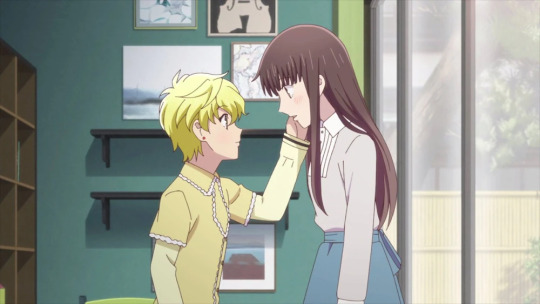

He also doesn't try to distract or manipulate Tohru when he realizes she's upset. He asks her what's wrong and listens, and he even cries with her.
Takaya also connects Momiji and Kyo in the structure of Ask Him For Me/manga chapters 74 and 75. Momiji's section of this episode is almost bookended by two appearances from Kyo.
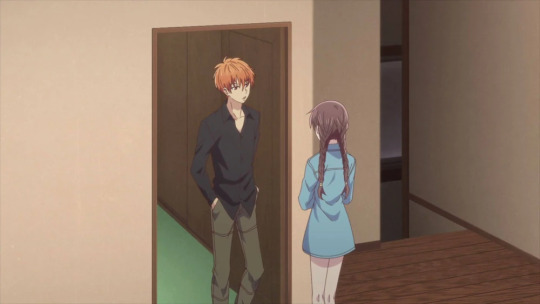
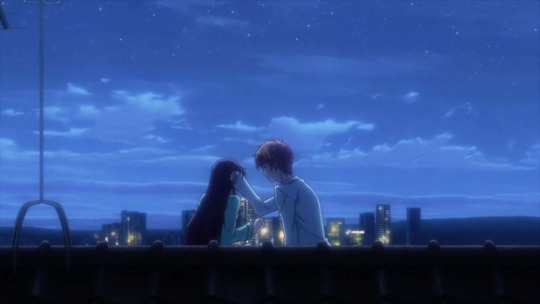
Near the beginning, Tohru asks Kyo about Kureno, and he warns her not to go looking for trouble. And at the end, we have that rooftop conversation.
Tohru: It's only natural to want to be with the person you love, to want to be by their side, right?
Kyo: What is it? Are you in love with some guy?
Tohru: N-n-n-no! It's not about me!
Kyo: Don't worry. When you do fall in love, you'll have my full support.
So, in this episode, we have Momiji trying to protect Tohru, and Kyo trying to cheer her up and spend time with her, a complete reversal from where they started relative to each other.
And then, Momiji grows up.
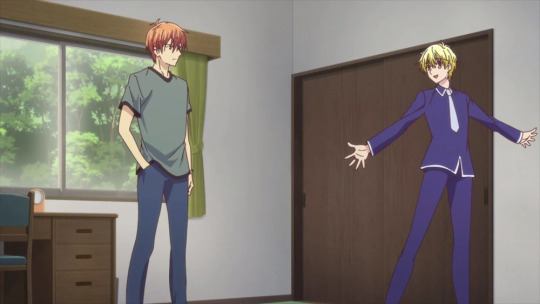
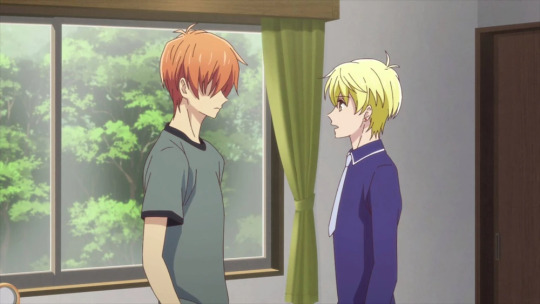
After Golden Week, a bunch of the kids gather at Shigure's house for dinner, and when Tohru notices that Kyo isn't with them, Momiji volunteers to go get him (Momiji really is always the one to invite Kyo to join everyone). In the manga, Tohru starts crying when she notices that Kyo's not with them, no doubt thinking of Kyo's upcoming confinement.
When Momiji arrives in Kyo's room, they have this exchange:
Kyo: You guys are gonna eat here, too?
Momiji: It's okay, we settled on curry.
Kyo: Whatever. You grew a lot, huh?
Momiji: Right? Pretty soon I might be taller than you, and better looking! And then, and then... maybe Tohru will accept my proposal? Do you get that if you give up, something like that might happen? So you shouldn't give up. I'm gonna stop going, 'There's no point in thinking about this,' and giving up. Wouldn't it sting if some other guy took Tohru from you? Well, look at the time! We better go help make curry! Come on!
In the manga, it's made clear that Kyo is horrified that everyone knows he loves Tohru. He stands separate from the rest of the group at the barbecue. In the manga, he and Tohru share a cute moment of blushing eye contact.
I love how Momiji says he'll stop thinking it's pointless, too, after he encourages Kyo not to give up. In a conversation where he could have focused on the fact that Kyo is his romantic rival, he instead focuses on the fact that they both might have futures worth fighting for. They're fighting beside each other, even if they can't both be the one Tohru loves romantically.
Later that episode (or a few chapters later), Momiji's curse breaks. He now has a real future ahead of him, but he sees how Tohru looks at Kyo, and he knows that his own future won't be at her side like he wants.


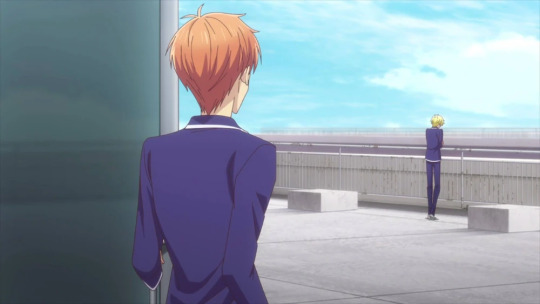

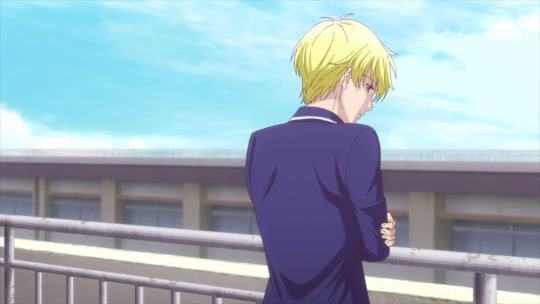
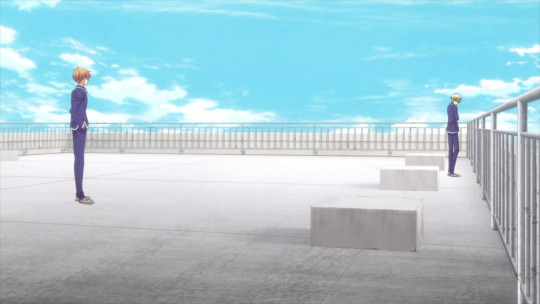

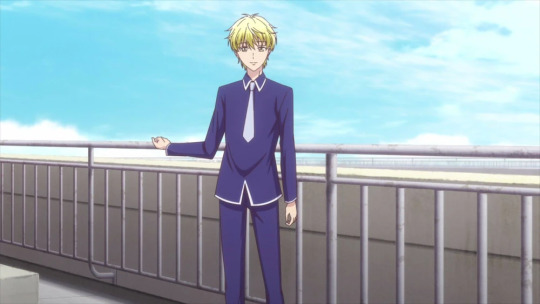

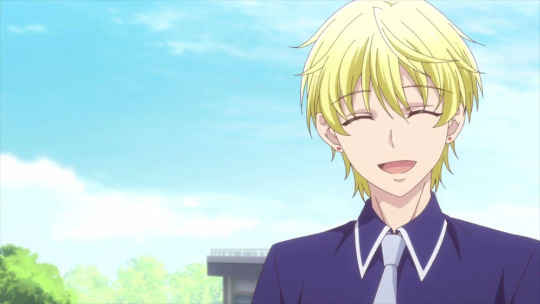
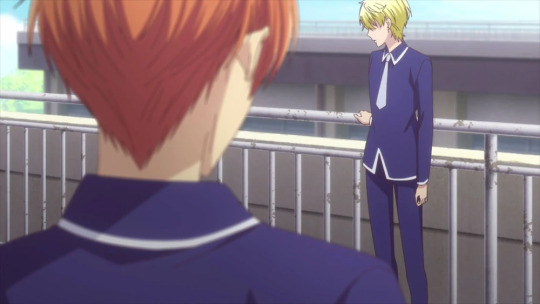
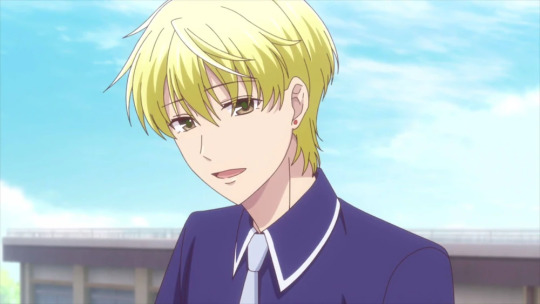


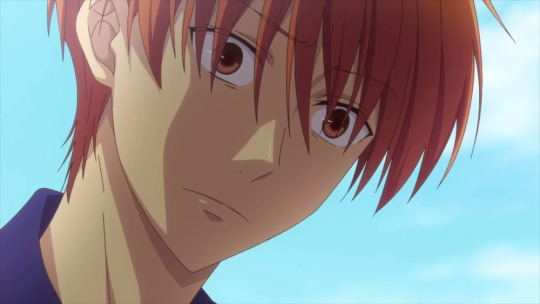
Kyo: Momiji? Jeez, you're here of all places. Tohru and them are inside looking for you, so-
Momiji: What?
Kyo: Huh? Uh, nothing. Did something happen?
Momiji: My curse is broken. Would it surprise you if I said that?
Kyo: What? Listen, you-
Momiji: Yours breaking would make Tohru happier than mine breaking. I'm sure she'd be happy. I mean... you know, right? I'm the one this stings.
Kyo: Shut up. I don't wanna realize that. It's too...
Gosh, this scene breaks my heart every time. On both of their behalves. Momiji is dealing with his first real heartbreak, and Kyo is dealing with his extremely complicated feelings about loving Tohru, his guilt over Kyoko's death, and his upcoming confinement in the Cat's House.
It's clear Kyo cares for Momiji in this scene, and Momiji really tries to put on a happy face for Kyo, but he can't. Megumi Han does an outstanding job as Momiji in this scene. The way her voice breaks when Momiji smiles and says, "Would it surprise you if I said that?" is just crushing.
The visual storytelling is stunning, too. The wide shots, emphasizing how lonely both Momiji and Kyo are. The way the scene is composed to emphasize the distance between them. The close-ups on their faces when they're each grappling with the thing that's gutting them. The way Momiji's smiles are always immediately followed by the saddest looks. The way their solo shots mirror each other's, at the beginning, middle, and end. We also don't see Kyo's eyes between the moment Momiji says his curse is broken and when Kyo is saying, "I don't wanna realize that."
Before the beach arc, I don't think Momiji would have watched that sort of interaction from a distance, and I don't think he would have let it stop him from making plans with Tohru. He would've just wanted to make her smile and spend as much time with her as possible, even if that meant ignoring her feelings. And he definitely wouldn't have let himself feel sad. Momiji's pain in this scene is evidence of his growth.
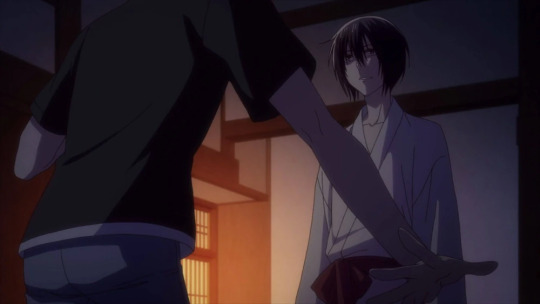
That night, Momiji goes to speak to Akito, after having dismissed her the night before. His speech to her might be my favorite moment of the whole series. It's the climax of Momiji's arc, at the very least.
Momiji: I'm sorry I sent you home alone yesterday. I spent the whole day thinking. Wondering why my curse is gone... only mine. I couldn't think of anything that would cause it. But I can say this: Akito, I can't stay by your side for the rest of my life. And you can't tie me down anymore.
[Akito slaps Momiji]
Akito: Monster! Traitor. Traitor!
[Akito beats her fists against Momiji's chest]
Akito: If you leave here, leave me, you've got no place to go! Your mother and father won't just welcome you back! No one will! You'll never be happy!
Momiji: I know. I've become so free, and so lonely. The curse breaking doesn't mean I'll get the girl I want. And the bonds that unconditionally connected me to everyone are gone. It's too late. I can't go back to before things were broken. But... but don't tell me that not having those things means I can't be happy! Don't just decide that! I feel vulnerable being free, but a happiness might exist for me! It might be somewhere in the future, waiting for me to catch up! I'm going to finally start walking along my own life's path. What about you? How long will you stay here? The person most afraid that if they leave this place, they'll have no home and no happiness...
Akito: Shut up. Just shut up. Get lost.
Momiji: Okay.
It's almost the credo of the whole series, isn't it? That it's better to make your own way, with no guarantee of love or happiness, than to cling to bonds that have become a burden and wish for things to never change. What Momiji's saying is what Akito needs to accept in order to be free herself.
And Momiji, despite all the loss he's suffered, despite having his heart broken that very afternoon, he's still determined to keep going.
I love this as the climax for Momiji's arc because it showcases the ways he's grown while also showing us the things that have always made him such a special character. He's standing up for himself and his future, not afraid to make Akito angry or say things she doesn't want to hear. He's acknowledging that it hurts, and that he might never have the family he so desires. But he also might.
It's a waste of time to think about loss or life getting harder. The traveler never thought about that stuff.
He still has hope, even as everything seems so dark. And he still tries to help Akito, even after everything she's done to him.
The parallels between Kyo and Akito in this episode/chapter are so well done. For both of them, the pain of moving forward is just too much right now, but Momiji still wants to see them both move forward anyway, and he's telling them this in a straightforward, mature way, rather than manipulating them.
And Momiji's not done affecting Kyo's arc.
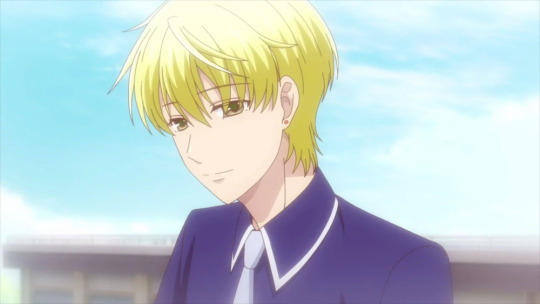
After Kyo asks Tohru if she loves him, we see Momiji's face and hear him say, "I mean... you know, right?" Once more, it's Momiji whose voice Kyo hears at such a crucial moment.
It's painful for Kyo to finally accept that Tohru loves him. He doesn't know she already knows about his confinement, and worse still, he knows he has to tell her about the day of her mother's death.
But again, it was Momiji who led Kyo to realize that he loves Tohru in S2, and now it's Momiji leading Kyo to realize that Tohru loves him, too.
After Kyo unloads his guilt on Tohru, and Tohru falls from the cliff, it's really Yuki who gets Kyo to take the final step toward accepting Tohru's love, so I won't say much about that except to point out that Yuki says making Tohru smile was protecting her, and that only Kyo could make her smile like that.
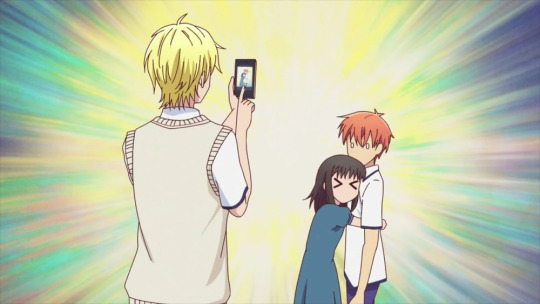
I think this scene, where Momiji and Kagura team up to tease Kyo, is the last time we see Kyo and Momiji together. But they're still affecting each other's arcs all the way to the end.
After Kyo and Tohru get together, they visit Kyoko's grave, and Kyo asks Tohru to move away with him.
It's selfish, and it's going to take Tohru away from everyone else, but he still asks anyway. It's a very Momiji-like thing for him to do.
And then, he says this:
I'm taking her with me. You good with that? I'll keep my promise. I know I'm really late, but... I'll protect her for life. So, we're good, right?
He's taking her with him, and he'll protect her for life. He's learned from Momiji, but he's still Kyo.
As they get ready to leave, Tohru starts reminiscing and starts to cry because she'll miss everyone so much.
Kyo: Clearly you don't get it. Listen up: everyone loves you more than you think they do. So it'll be okay. This isn't the last time you'll ever see them. It's the start of a new banquet, right?
In his last appearance, Kyo hugs her and cheers her up and offers a healthy dose of optimism for their future.
And the last time we see Momiji, he's sitting at the dojo with Haru and Rin.
Momiji: More importantly, how dare Kyo take Tohru with him! I bet he just wants her all to himself. I wanna pinch him! Really hard!
Haru: Why not pinch him tomorrow?
Momiji: Nah, I can't do it in front of Tohru. Oh, but thanks to him, I have another dream. I'm going to find an amazing significant other, and we're gonna go visit them just to show off! So Tohru had better stay happy. She'd better keep on smiling, or I'll be disappointed.
He's complaining and getting annoyed at Kyo (and threatening light physical violence!), but he's still dreaming of a bright future for himself. And he's trusting Kyo to keep cheering Tohru up in their new home.
When I started thinking about writing this series, the point I thought I'd be making was that Momiji functioned as Kyo's mentor in Fruits Basket. But after putting these posts together, I really think it'd be more accurate to say they were each other's mentors. Their relationship has a mutuality from the start. I hope they remained close as adults.
And I really hope Momiji found an amazing partner.
Momiji and Kyo: Part 1 | Part 2 | Part 3 | Part 4
Here's a plug for my fic, Bloom Within Us. It's a canon-divergent AU where Tohru dies after falling from the cliff. I've really enjoyed exploring Momiji and Kyo's relationship in that story. If you've enjoyed this series, I hope you'll check it out!
#fruits basket#furuba#fruba#kyo sohma#momiji sohma#akito sohma#kagura sohma#tohru honda#hatsuharu sohma#furuba analysis#fruba analysis#fruits basket analysis#character analysis#analysis#rich characterization#character traits#character development#story structure#kyo and momiji are basically brothers!#romance#kyoru#kyo x tohru#my meta#by cinderella-ish#character arcs#complementary character arcs#fanfic#ao3#ao3 fanfic#ao3 link
22 notes
·
View notes
Text
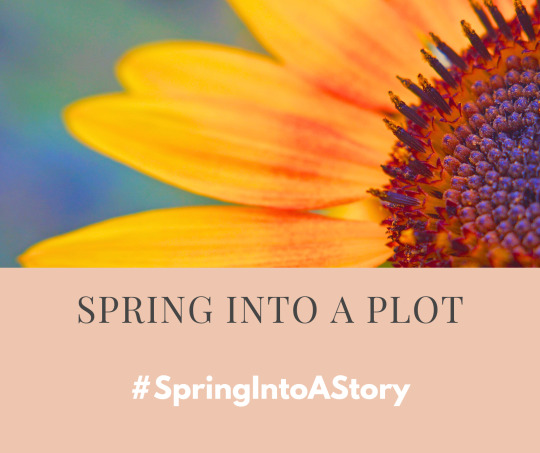
What if it's not character that's your problem, but the structure of your story? How do you plot?!
While the plot of a novel is a series of events unique to your tale, the structure of it is probably very similar to other works and as such, falls into one of these plot types.
Vs Fate (luck, destiny) - Have your character fight against the inevitable - a prophecy, a prognosis. Percy Jackson never actually escapes the prophecies, and the characters of Fault of Our Stars fight cancer every step of the way.
Vs Self (need vs want, need vs morals) - Have your character fight their own nature. This is a common plot structure for character-driven novels and is often the basis of a character arc. Think Diana Prince in Wonder Woman 84 torn between her want (her lover) and her need/morals (saving the world)
Vs Society - Rebellion! Society can vary - maybe it's the ruling class, maybe it's the patriarchy, maybe it's capitalism (solarpunk, anyone?). In any case, characters in these stories are fighting the structural aspect of a society or the establishment upholding it. Luke Skywalker is going against the Empire, and the ladies of Hidden Figures are fighting racism.
Vs Supernatural - This is when the threat is a supernatural element, which isn't every fantasy story. Think the Exorcism or monster-of-the-week TV shows.
Vs Technology - This is when technology is the bad guy your characters must stop. It can be in an action movie - like Terminator - or it could be in a political drama about the atomic bomb.
Vs Family - These plots can be similar to the vs society setup, but the group your character is fighting against is more personal because it's their family (found or not). Encanto is a good example of this - Mirabel struggles with her place in the family while her siblings struggle with the pressure to keep Abuela happy.
These are basic plot structures, the high-level action of your story. The details of how these play out will depend on your characters and setting.
#writing#writeblr#creative writing#springintoastory#spring into a story#writing community#writblr#writing advice#writing tips#writing challenge#plotting#creating plot#story structure
22 notes
·
View notes
Text
I think people underestimate the changes that need to be made to stories when adapting them to different mediums/structures and maybe if they understood, they wouldn't have such issues with scenes/character moments not being 1-1 adaptations.
The structure of episodes is really important when considering how the story will unfold and what to include in each episode. Every single episode needs struggles and payoffs, a goal and an accomplishment of that goal - especially in an episodic show like the animated ATLA. By necessity of this, each 20 minute episode is going to have a lot of stuff going on - and tons of issues cropping up where character can be shown. Also, it's common to only have one plotline being followed per episode per group of POV characters - often it's Zuko's plot (much less screen time) and the Gaang (more screentime).
When you only have 8 episodes, cramming all that in would make the episodes feel disjoined and cluttered. It would be a constant whiplash of 'small struggle, overcoming, small struggle, overcoming, small struggle, overcoming' and all those little struggles together might start to feel insignificant and like the plot is just trying to come up with something for the characters to be doing. An example that might have been frustrating is in the first episode of the live action, having Aang and Katara travel to go penguin sledding, then jump to the fire nation ship where they reveal Aang's been gone so long, then back to the village to yet again talk about how long Aang has been gone (to catch everyone up), then Aang leaves, then Aang comes back, then he's off on the ship, then Katara and Sokka have to figure out how to get Appa to work, then they go to the ship, they fight on the ship, Katara struggles to figure out how to waterbend, Aang goes into the Avatar state, they escape, they go to the southern air temple, Aang plays around, they figure out Avatar stuff, they chase Momo, Aang goes into the Avatar state again, Katara talks him down, then the goal of the narrative is introduced.
While that works spread across three whole episodes - episodes not meant to be watched back to back but rather week to week as well as the writers understanding that since this is a kid's show airing, it's possible the watcher has missed the episode before - it would not work for hour-long episodes intended to be binge watched. When the show is episodic and people might not be able to catch all of them, a unique issue needs to be introduced each episode and resolved that same episode (minus the few 2-parter storylines in the OG). It's just the nature of that sort of structure. Just like you wouldn't want a comic structure in a chapter book or a movie structure in a serialized show, different mediums require different structures.
So how to resolve this? We've got one hour to do all that in - so instead of having all that time traveling (or gods forbid just jumping to the next setting without any establishing shots/travel scenes), things need to be condensed: which means, take several individual actions that share a common theme - say, how a character reacts to certain issues, and combine it into fewer actions that flow in a single sitting rather than three individual ones. Not only condense individual scenes, but also weave together multiple plotlines that might have been in separate episodes, but share a common theme, and have them all occur simultaneously. This means that specific beats from each of the 20 episodes might not all fit in the episodes, but the spirit of those scenes can be adapted to fit with the situation that's at hand - I think episode 3 in the live action does this masterfully.
A specific example is moving Zuko and Aang's first one-on-one fight from his ship in episode 2 of the animated series to episode 3 in Omashu - combining that with the epic fight between them at the perfume place. Episode 1 had already had many fight scenes and one more might have blended in with all the others - setting this big, impactful fight aside for the moment until it could be…well, a moment, I think was a good choice. It was different, an adaptation, but it held true to the significance of the interaction as well as weaving in to the other storylines.
So again, the change of medium is going to necessitate many scenes to be altered to 'fit'. Though many scenes can be translated pretty closely to the animated counterpart, all of them won't be and if you think every single character beat being shown is a must in order to understand character, then just go watch the OG, a different structure just won't work for you point blank no matter how well it's done. Trust me, you do not want to try to just shift a 20 episode season into 8 episodes with no structural changes despite the raw run-times being similar - it would be bad. Like really bad.
#media analysis#story structure#natla#natla spoilers#avatar the last airbender#live action avatar#netflix atla#this argument that 'they had the same amount of time as the cartoon so that means they have no reason not to include every single scene' is#just wild to me#story structure is IMPORTANT PEOPLE#this should be very obvious but apparently it's not#there's not just one way to show specific character traits - the same trait can be shown in a different type of scene just fine
24 notes
·
View notes
Text
Alternative Story Structures/Patterns (a.k.a how to avoid that damn triangle)
Disclaimer: these are all taken from Jane Alison's Meander, Spiral, Explode under the idea that we should draw more from patterns in nature when structuring works of fiction. Alison is a white woman, and a lot of non-western storytelling (especially utilizing different structures other than the triangle/wave) was pioneered by Authors of Color. I highly recommend you also research types of non-western nonlinear storytelling that Authors of Color have been utilizing and pioneering way before western storytellers even began to think about them. Here's a great article, and here's another one to begin your research there!
I'm gonna start each section with a quote from Meander, Spiral, Explode that I think explains them best, and then extrapolate where I can from there!
Waves
I've already discussed this one! If you wanna know my thoughts and feelings about the wave (a.k.a Evil Triangle That Might Have Some Uses, Maybe) you can check out this post here!
Wavelets
"Once I translated the dramatic arc to a wave, I began to think that energy in narrative might also flow in smaller waves, wavelets. Dispersed patterning, a sense of ripple or oscillation, little ups and downs, might be more true to human experience than a single crashing wave: I'm more likely to feel some tension, a small discovery, a tiny change, a relapse. The same epiphanies every week..."
I love the idea of this, and her comparison to the human experience. I feel like we sort of tried to accomplish this by adding various peaks to the original triangle, but sometimes a narrative can have multiple waves. She talks a lot about how this can show up as patterning in stories as well, moving back and forth between two different energies that could be important to a character, back and forth between motivations. I don't know if that makes any sense, wavelets aren't really my style, but I know they'll resonate with someone, because what are we doing if not trying to connect to the human experience?
Meanders
"A meander begins at one point and moves towards a final one, but with digressive loops. Italo Calvino says that "digression is a strategy for putting off the ending, a multiplying of time within the work, a perpetual evasion or flight. Flight from what? From death of course!" The Meander river in Turkey gave us the word, and speaking of how an actual river flows, Peter Stevens (in Patterns in Nature) says it "winds and turns in a quiet but seemingly desperate manner to avoid the straight schuss to the bottom"... In either case, there's deliberate slowness, a delight in curving this way or that, luxuriating in diversions, carving slow labyrinths of time."
OHHHHH THE MEANDERING NARRATIVE. I do enjoy this one, it isn't my favorite, but it is very very good. I specifically love the part she mentions about the narrative being afraid to reach its end. Sometimes characters meander, they want to experience the slowness, to stop and enjoy the things that are going on around them before moving forward with the plot. If you learn how to use the meander to your advantage, people who have a tendency to under-write could seriously be helped out by trying to do this. Also, sometimes people's minds just wander. Why should a narrative not wander too? A river will always end up spilling out somewhere, after all.
Spirals
"A spiraling narrative could be a helix winding downward– into a character's soul, or deep into the past– or it might wind upward, around and around to a future. Near repetitions, but moving onward. What gives a spiraling narrative a good sense of ending? Good question, for spirals could go on forever."
and also
"I wonder if first-person retrospective narratives– especially obsessive ones– might naturally follow a vortex."
Can you tell which quote gave me my epiphany about Verity and To Make a Fool of Death? Maybe it's mixed in with the radial narrative (right below this!!) but a spiraling narrative is truly a beautiful thing. This one and the radial one are both truly very deeply character focused, which makes me happy. The idea of telling a story based around a character, or just always coming back to the central of the character, is deeply fascinating. At another point in this chapter, she compares the spiral narrative to like the spiraling of a panic attack: you start thinking, and then you think more, and the problem becomes bigger, and you just keep going and then you cannot stop. Whether your spiraling narrative is fast, slow, or somewhere in between (not even gonna go off on a tangent about combining some of the patterns like a meandering spiral), it wanders around but remains true to the central core of what STARTED the panic attack, and will always have come from that true center.
Radials or Explosions
"Unlike in a spiral, the story itself– the incidents we see dramatized– barely moves forward in time. Instead, a reader might have a sense of being drawn again and again to a hot core– or, conversely, of trying to get away from that core. You might already know the end at the start and get many fractured views of things avoiding that moment. You might feel a sense of violent scatteration from a central point. Radials can be centrifugal or centripetal, but linear they are not."
This one might just be my favorite. Her example for it is truly perfect, too. She uses Gabriel García Márquez's Chronicle of a Death Foretold to talk about the point of this one. The entire story revolves around the death of this one man, we know he's going to die from the beginning of the story, and everyone else knows it too. We get the reactions of people to the idea of his death, the effect his death has on others, the WHY of his murder, and so on and so forth. The entire story centers around the hot core of the death of the main character, and that is BEAUTIFUL. I don't know what else to say about this kind of narrative outside of that example, because it does exactly what the radial/explosive narrative requires of it. Vignettes that all center around a big, dramatic point. That kind of thing. I love it, I can't get enough.
Networks or Cells
"So, again, any complex narrative will be a little spatial: certainly the spiraling or radial ones we looked at are. I think the idea of spatiality becomes most clear in cellular texts made discrete parts that gain power through patterns of images or ideas rather than sequential incidents." [section removed where she's talking about three examples provided to prove her point] "In all three, no linear chronology makes the parts cohere; instead, you draw the lines."
and also
"Translating to natural patters, I think of Peter Stevens's words about honeycombs or foam: 'chunks of space, miniature rooms, each one different from its neighbors and yet perfectly interlocked with those neighbors'."
I feel like these really speak for themselves. Think like... a short story collection, right, where all of the stories are seemingly unrelated, but you're able to connect the dots in your own mind and realize how these narratives are actually entwined in some truly beautiful ways? This method places a lot of trust on the reader, and I think that's important. As long as you have readers who have an ounce of critical thinking skills, of course. Stories like this are particularly interesting, especially when you as a writer have to decide how to subtly connect them all, or how MUCH you even want them to be connected.
Fractals
"The most fractal works– meaning fractals of fractals– were stream-of-consciousness narratives, although it's not clear whether that style reveals depths of consciousness or the writer's imagination. But fractals forming the shape of a whole narrative are what interest me: Texts that start with a "seed" or blueprint that spawns several more."
and also, in reference to Caryl Phillips' Crossing the River, an example of a Fractal Narrative:
"Instead the book is polyphonic, taking the points of view of four characters and delivering them in different styles: letters, diary entries, mixtures of third person and first. Yet the stories all grow from a single seed..."
I cut off the last one, but to give some context: Phillips' Crossing the River is the point of view of four characters across time periods that are stories that are inherently related to each other, in that they all stem from the same fractured point, but the linear plot lines do not connect. That's why it's so interesting. It kind of reminds me of the butterfly effect, right, but in a narrative sense. One action that someone takes will fracture, splitting across the story and creating so many smaller, new stories that are just as integral and wouldn't have happened without that first fracture. Will it all come together and will the fracture heal and reconnect at the end? Idk, maybe, it can. It's more of an exercise in seeing what happens based off of one simple event.
Additionally...
She has an entire chapter at the end called "Tsunami?" where she talks about David Mitchell's Cloud Atlas, which is like... a wave, right, a symmetrical wave, but SO MUCH MORE THAN THAT. Remember in "networks or cells" where I was talking about stories that don't seem to be connected but then there's a beautiful through line that somehow magically connects them all? And then in the wave post, when I talk about symmetry and traveling up the wave and down the wave so that the end reflects the beginning again? Cloud Atlas does all of that and more. I couldn't recommend this book enough. It's impossible to explain. It's perfectly written. I honestly don't even really consider it one of my favorite books, but I know that it has FEW rivals for how actually good it is. And, again, PLEASE DO NOT WATCH THE MOVIE.
If anyone wants extrapolation on any of these specifically, I'd be happy to talk about them in their own individual posts, if you've got something specific you want to know more about!! I mean fuck, I might write more about them later on just because I want to and I have feelings. All I really did here was just kinda explain them. And, once again, I encourage you to seek the perspectives of Authors of Color for this one as well. Countries that aren't North American/European have been doing this way longer than us, and those formats deserve some fucking respect.
I also of course have a few people that have asked to be tagged in my posts like this, and if you'd like to add yourself to this list, please let me know! I'll be posting a bunch of these as I go through grad school, so there's a lot to learn! @approximately20eggs @faeriegutz @moonscribbler @marigoldispeculiar
#writeblr#creative writing#writers#writing life#writing#writing reference#story structure#writing advice#fiction writing#writers of tumblr#novel writing#writing community#writing concept#grad school#studying#novel structure#about the author#my writing#my wips#long post
574 notes
·
View notes
Text
Love In The Air - Three Act Structure
A while back, I wrote a tweet thread on the story structure of MeMindY’s popular BL series, Love in the Air, specifically how romance-as-plot is used. Here is that thread:
I half-witnessed a Twitter stoush a few days ago, which prompted me to post a thread, and now, this post.
A bit of background - someone was tweeting about how much they loved BL drama Love In The Air (13ep series on iQiYi and Viki), and Twitter being Twitter, someone yucked their yum and bitched about how it basically had no plot. *sigh* so here we go, my 2c on story structure and how it applies to Love In The Air (it’s a breakdown of Payu and Rain’s story, which is the first 7 eps. Prapai and Sky feature in eps 8-13).
Fact: BL are stories about love. It's literally there in the descriptive, "boy love". No love? No plot. By definition,'plot' is a series of events that happen from beginning to end. And here's the thing - romance-as-plot has been around for centuries. It's the backbone of the billion-dollar romance novel industry. Just because there's no dead body, or people running from bad guys, or world disaster, or vampires taking over the city, doesn't mean there's no plot. The romance IS the plot.

Romance in BL is a must-have. Imagine picking up a murder mystery novel and not getting a murder or a mystery. A crime story with no crime to be solved. A romance novel must have A ROMANCE: two (sometimes more) people meet, encounter obstacles to their love, overcome their issues/obstacles, fall in love, admit love, end up happy. That's it. It's as simple and as complex as this. So let's apply storytelling structure to Love In The Air and see why it fits perfectly into the romance genre.
Act 1 (Set Up)
Ordinary World - Our main characters are doing their thing in their normal, everyday world. Hot seme Payu is racing bikes, doing architect stuff and working in his garage. Bratty-but-cute uke Rain is a 1st year architecture student, crushing on a disinterested girl. Payu is a senior at Rain's school and a bit of a legend. All the students are heart-eyes for him, and that pisses Rain off.
Big Picture Question - will Payu and Rain fall in love and end up together?
Call to Adventure - Payu makes it clear he fancies Rain.
Refusal of the Call - Rain does not want, plays hard to get.
Acceptance of the Call - Rain and bestie Sky break into a private street race event, Payu rescues him. This pisses Rain off and now he wants to show his classmates Payu isn't all that. Tells Payu he will make him fall in love with him.
ACT 2 (All the Stuff Happens)
Crossing the Threshold - with Payu accepting this challenge, Rain is now part of Payu's world.
Learning the Rules - Payu lays down the ground rules if Rain wants to see him - no cursing, call or text before showing up.
Mentors/Allies/Enemies - Rain's bestie, Sky, plus his school mates. Payu's bestie Prapai, and his bro, Saifah, plus the garage workers. Bad guy, Stop. And Chai, the 2IC for the rich street racer owner.
Trials/Failures/Successes - Rain has to swallow his pride and follow Payu's rules. Rain steps from his comfort zone and publicly declares he's pursuing Payu. Rain stops focusing on school, fails to submit an assignment. Payu chastises him for neglecting his studies. Rain works hard and finally gets praise for an assignment, and Payu is the first person he wants to tell.
Point of No Return - Rain's reward for his hard work is intimacy, praise and lovemaking. Payu accepts Rain can 'stand by his side'. This is further emphasised when Rain (a submissive uke) takes a more dominant role in the bedroom (btw their love scenes are fire)
-----> Story midpoint <---------
Escalation of Intimacy - talking, sharing of thoughts, ideals, emotions. Rain makes the first move with intimacy/kissing. Is no longer bothered being known as 'Payu's boy.' Also known as ‘removing the armour’ which is where our lovers are relaxed and trusting of the other enough to reveal the inner emotional stuff - secrets/dreams/hopes/trauma etc.
Oh Shit Moment - Rain is abducted by asshole Stop, which is revenge for having lost a bike race to Payu. Payu is forced to bow, is beaten up and it looks like our heroes won't get their happy ending???
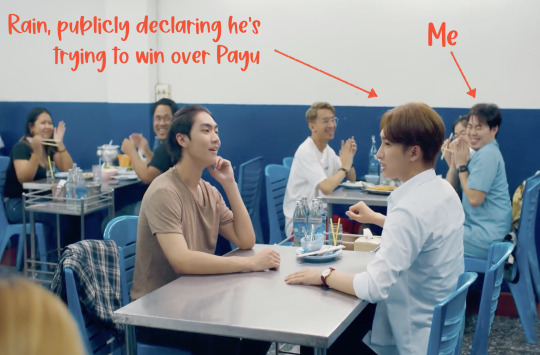
Act 3 (New Improved World)
But Then, Victory - Chai to the rescue, Stop is stopped (ha!), Payu and Rain are saved.
Return to the New, Improved Ordinary World - Admission of love between Rain and Payu. Rain publicly declares Payu is his boyfriend in front of all his friends. Big Picture Question is answered and PayuRain get their happy ever after.
So there you have it - boys meet, overcome their emotional issues, fall in love, face challenges, admit love, finally get a HEA. This is a classic romance story in a nutshell.
FYI, I developed these 3 Act stages using a combination of Christopher Vogler's A Hero's Journey, and Michael Hague's 6-Act story structure. They are both experts and veterans in story telling structure.
#love in the air#bl series#thai bl#bossnoeul#boss natthaphon#noeul nuttarat#mame#memindy#writing#story structure#screen writing#three act structure
99 notes
·
View notes
Text
youtube
Video essay recommendation!
Are you a fiction writer? Do you struggle to make people connect to your story and characters? Do you find yourself hoping your audience cries, but not knowing how to MAKE them cry?
You don't need to know anything about Fire Emblem or Engage to get something from this video - I was super impressed by this breakdown. It's a good long watch, and is very entertaining to boot. Highly recommended!
52 notes
·
View notes
Text
Young Royals and the three act structure, Part two
Here we go again! Last time we spoke about how season one is constructed within the three-act structure. If you haven’t read the previous post I’d recommend you do so, because I’m not gonna explain each plot point again. Now we shall look at how this applies to the rest of the show, and based on that make a small prediction about season three.
So now that we’re all up to speed, let’s get to it!
I wanna take a moment first to consider Wille’s Want vs Need in regard to season two. The Want hasn’t really changed - He still wants to be with Simon. Although we are now aware of his Need, because of how the previous season ended, his struggle now is more about how to get there. Essentially, coming to terms with taking accountability and committing to his values. Consider where he’s at the start of the season, compared to the end. In episode one he calls his mother and literally blames her and the court for everything. Missing the point that it was his own lack of communication that drove Simon away from him in the first place. He’s not ready to take accountability yet. That’s why he can’t have what he wants. In the end though, in episode six, that’s exactly what he does. He admits he was in the video with Simon, to correct what he did wrong. The emotional journey he’s been through this season pushes him to actively make decisions based on his own beliefs, not letting the crown manipulate him anymore. Wille has become fully aware of what he Needs.
We continue our structure analysis with season two. And I gotta be honest for a second, I struggled a bit identifying some of these beats. They’re not as grand as they were in the previous season, making the structure a bit less obvious. The way I see it, the second act this time around is veeery long. But once again, if you disagree with me, let’s chat!
Act 1
Act tension - Can Wille and Simon resume their relationship?
Sequence 1
Set up/Hook - Since this is season two, we already know most of the characters and there’s no need to go deep about what is plaguing Wilhelm, we know what happened last season. But when we catch up with him, it’s clear he’s had a terrible Christmas. He’s sad and alone in the castle, doesn’t speak to his mother, and is very angry at August. Then he returns to Hillerska.
Sequence tension - What’s gonna happen when Wille and Simon reunite?
Point of attack - Wille is eager to be around Simon again, but Simon is trying to avoid him and even asks for space.
Inciting incident - Wille finds out about Simon’s date with Marcus.
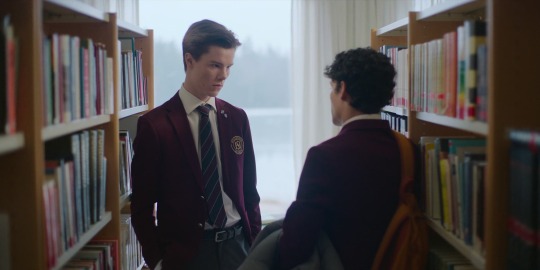
Sequence 2
Sequence tension - What is Wille gonna do with this new information?
Things are moving rather quickly here because again, this is the sequel, there’s no need to linger on the set up. So we are immediately faced with the first major plot point, the Lock-in - Wille calls the royal court and blames them for everything that’s gone wrong so far. He also makes the decision to actively fight them, by threatening to renounce the crown. This also establishes the royal court as the main antagonist for this season. August is still an antagonist, but no longer the main one. The main tension is also established.

Act 2
Act tension - How will he win Simon back?
Sequence 3
The protagonist starts this sequence having learned something new - Simon is making attempts to move on. Wille responds with petty anger. Then we get a pinch point - Jan-Olof shows up to remove Wille from Hillerska. Demonstrating the royal court's power.
Sequence tension - Can Wille stand up for himself against the crown?
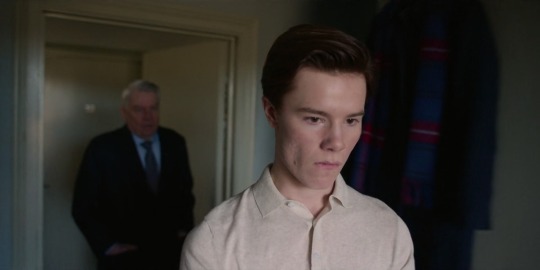
Sequence 4
The build-up towards the midpoint - Felice advises Wille to be around Simon as much as possible, to keep trying, and that he does. Like bargaining with Simon about having a secret relationship, helping Simon get a spot on the rowing team, and confronting him about his relationship with Marcus.
Sequence tension - Is Simon actually moving on?
And here comes the dreaded midpoint once again - Wille sees Simon and Marcus kiss. He now believes he’s lost Simon forever. What we could call “A false defeat”. This changes his aim from winning Simon back, to attempting to move on himself.

Sequence 5
Wille is trying to adjust to this new reality where he can no longer hope for Simon to come back to him. We could identify two pinch points here. One is the locker room fight, where Simon admits he can’t accept Wille's title. And the other is when Simon shows up at the ball with Marcus. Both of these remind Wille of the fact that he can’t be with Simon.
Sequence tension - Can Wille let Simon go?
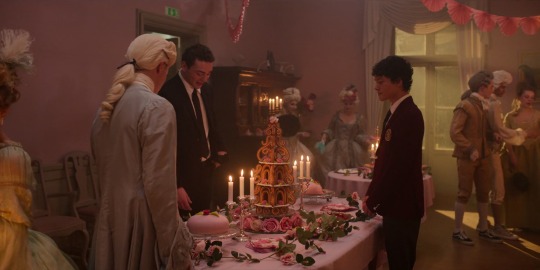
Again, some subplots advance here - Sara and August’s relationship intensifies.
Sequence 6
Starting with a plot point, a moment of reflection for our protagonist - Despite Wille’s attempts to let go, Simon runs after him at the ball. They end up kissing.
Sequence tension - They still love each other!
Wille is overjoyed by this turn of events, and for a moment believes that they can be together again.

Sequence 7
Just like last time, Young Royals drags out the drama by adding an extra sequence here. A pinch point - Another reminder of the royal court's power. Kristina telling Wilhelm that August is next in line to the throne after him. Their argument in the music room could also be accounted for here.
Sequence tension - Wille is starting to realise how much his title affects Simon.
Wille’s offer to give up the crown could be more considered as a character-building moment, rather than a plot point. And Simon’s decision after this is more of a plot point in his own storyline.
The crisis that serves as build-up to act three - August threatens to report Simon for the drugs, if he reports August for the video. Wille reacts very strongly and takes it as a personal attack.
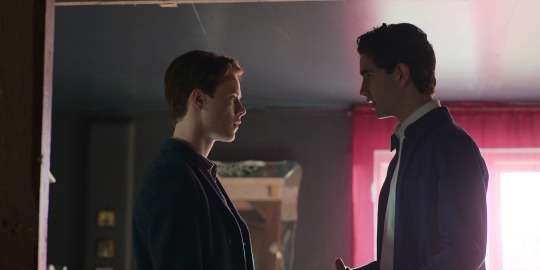
The end of act two, where the protagonist faces their biggest challenge yet - The aftermath of the field scene. Wille is alone again, Simon isn’t talking to him, and his title has badly hurt Simon once again. On top of all this, he has to do the speech.
Act 3
Act tension - Can Wille do the speech?
Sequence 8
Here the protagonist will make a big decision - Though perhaps is more Simon making the decision, to have a secret relationship.
Then we have the last major plot point, the twist - Despite the fact that Wille absolutely does not want to do the speech, he does it anyway, because he can’t let August be rewarded.
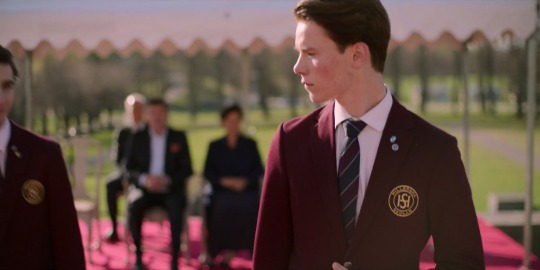
Sequence 9
Sequence tension - What is he gonna say in this speech?
The climax - Wille stops, considering the contents of the speech, and disagrees with it. He decides to admit it was him in the video.
Resolution - The smile they share I guess? But it’s still an open ending since this monumental decision leaves us with many question marks. Preparation for season 3.

The show obviously consists of so much more than just these beats, like subplots and character-building moments. The purpose of these things should be to strengthen the characters, as well as add more depth to the main plot. Take our beloved fish scene as an example, it doesn’t really do much to advance the plot. But it’s a very good moment for solidifying Wille and Simon’s relationship! Which is important to keep us, the audience, invested in their story.
Subplots are quite interesting and tricky to get right. They tend to follow the same structure as the main plot. It’s also common for subplots to cross paths with the main plot as well, and sometimes even fundamentally affect it. However, since the main plot should always focus on developing the protagonist, you shouldn’t let any of the other character’s arcs hijack it. But you also generally don’t wanna keep the two narratives completely separate, because then the subplot might end up feeling forced and meaningless. A great example from Young Royals is the drug plotline between Simon and August. Let’s break it down real quick.
Act 1 - the deal
Set up/Hook - August approaches Simon. Clearly, they are not friends.
Inciting incident - August asks Simon to get booze for him.
Lock in - Even though Simon initially declined the offer, he eventually agrees to help August.
Act 2 - the money issues
Pinch point - August returns and now asks for drugs, despite being late with the payment.
Midpoint - Simon learns August can’t pay him back because August is broke.
Pinch point - Simon gives August more drugs to sell, so he may pay him back.
Crisis - August threatens to frame Simon for the drugs after the party. (The plot lines cross and affect each other)
Act 3 - the threat
Climax - Wille manages to convince the others to frame Alexander instead.
Resolution - Simon is safe (for now)
The reason why I don’t account for Simon going to see his father here is because I’d argue that them reconnecting is its own subplot, more related to Simons relationship with Sara, than it is to the August situation. It’s also an unresolved plot line still. Micke showing up at Lucia I suspect to only be their crisis point, or maybe even midpoint? Depending on how the rest of it plays out in season three of course.
Another neat trick writers may use with their subplots, is to parallel the main plot, either to highlight the themes of the story, or to explore alternative outcomes. For example, the Sara and August plotline at times resembles Wille and Simon’s plot, for very good reasons. Like how August and Wille are from similar backgrounds, yet they’re very different people. Especially at the end of season two. By that point the emotional journey August has been on, falling in love with Sara and reflecting on his wrongdoings, you’d assume he would have learned something or displayed some kind of character growth. But nope. Instead, he doubles down and causes further intentional harm to the people he’s already hurt. While Wille, in the same episode actively works to redeem himself to Simon. This is meant to strengthen Wille’s position as the protagonist we should root for, by comparing him to August, who remains to be an awful person. So even though it may feel like season two is giving more screen time to the secondary characters, that still has a purpose for the overall narrative.
Young Royals in general like to use their secondary characters to highlight the overall theme of the show. As @darktwistedgenderplural pointed out to me, widening the view of Wille’s Want vs Need to the want of being loved for who you are, and the need to be your most authentic self, we find that the same principle can be applied to all the five main characters. Despite all their journeys being unique, their wants and needs remain universal. They are all there to strengthen the theme of the show.
So what was the point of all this rambling? I don’t think it’s a coincidence that the story consists of exactly three seasons. The way I see it, since the three-act structure can be found in every element of this show, each season is also meant to represent one of the acts. Season one is the set up, season two is the confrontation, and season three will be the resolution. If we try to map out the entire show that we have so far in the structure format, you can quite quickly find the pattern.
Season 1
Set up - Wille is sent to Hillerska where he meets Simon and falls in love.
Inciting incident - The video is released.
Lock-in - Wille does the statement and Simon breaks up with him.
Season 2
Pinch point - The royal court proves to be a major obstacle to Wille getting what he wants.
Midpoint - Wille and Simon kiss at the Valentine’s ball, proving they still have feelings for each other.
Pinch point - The royal court is still trying to manipulate him, making him do the speech.
Moment of reflection - Wille considers how much his title affects Simon and chooses to come out.
My theory is that at the start of season three, we’ll get to the Crisis point of the over-arcing plot. Where our protagonist will face their biggest challenge yet and be at their lowest point before the climax. And hopefully, we’ll get a proper resolution this time around! (Something more than a cliffhanger at least, please and thank you)
So even though it’s sad that our lovely little show is coming to an end, I think it’s worth looking at the bigger picture here. The writers clearly intended for it to have three seasons so that we would have a satisfying story with a clear beginning, middle, and end. There are so many examples of shows that self-sabotaged by running for way too long and not being able to keep consistent quality. But the Young Royals team got to stay loyal to their story and tell it in their way, and I think that’s beautiful.
Young Royals is a love letter to storytelling, and you can’t convince me otherwise ❤
#so that was basically a free uni lecture#hope you enjoyed#young royals#wilmon#Prince Wilhelm#simon eriksson#young royals analysis#august horn#young royals season two#Film Theory#story structure#three act structure#story analysis#young royals and the three act structure#my analysis#my meta
136 notes
·
View notes
Text
Thought up a structure for scenes/chapters that I really like. It helps me a lot.
Mystery: (initial main question that was hinted at in the previous chapter or in the first paragraph of this one; a promise; a major story beat that has to be answered partly or fully by the end of the chapter; it has to be an obvious question(s) that you inspire in reader's minds)
Revelation: (the answer, that might reveal partly or fully the answer to the initial main question of the current chapter/scene)
New mystery: (the revelation should inspire another question, like a plot twist/revelation the reader has to know more about; said question has to be answered fully or partly in the next chapter/scene)
Side note: if needed, for a short story each part can be divided into paragraphs or scenes; if it's for a chapter each part can be divided into scenes.
Rinse and repeat until you have a whole story/novella/novel.
#writing tips#writers on tumblr#adhd writer#writing community#writeblr#writing#writing tip#story structure#writing advice
29 notes
·
View notes